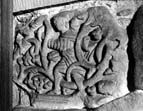Select a site alphabetically from the choices shown in the box below. Alternatively, browse sculptural examples using the Forward/Back buttons.
Chapters for this volume, along with copies of original in-text images, are available here.
Object type: Incomplete architectural sculpture
Measurements: H. 28 cm (11 in); W. 38.8 cm (15.75 in); D. Built in
Stone type: Medium-grained yellow sandstone
Plate numbers in printed volume: Pl. 98.525
Corpus volume reference: Vol 1 p. 115
(There may be more views or larger images available for this item. Click on the thumbnail image to view.)
Part of a frieze showing a plant-scroll inhabited by men and a beast. The top of the frieze has been cut away but the lower partly survives in the form of outer wide flat-band and inner roll mouldings. The plant seems to be a form of tangled horizontal scroll with strongly marked bindings on the nodes and thick side tendrils. The tendrils terminate in trefoil berry bunches or composites with sheaths framing buds or berries and one pointed and lobed veined leaf. On the extreme top left are the snout and front paws of a beast which grips and gnaws the stems, and, facing him, left arm outstretched and right arm upraised, is a male figure. He is shown in profile, naturalistically striding over the branches, and appears to be bare-footed. His hair falls in a lock behind his ear. His features are conveyed lightly, his eye by a single punch mark. He is dressed in a short kirtle with what seems to be a fold around the waist which passes over his shoulder and flies out behind him. On the bottom right is the head of another figure facing in another direction and in a different plane.
It is not clear whether this scene has any symbolic or biblical significance or whether it is merely a copy of a Classical hunting scene. In other Anglo-Saxon plant-scrolls, apart from Dacre and Hoddom, the figures in inhabited scrolls are archers. In facial type the figure closely resembles those at Ruthwell, especially the figures of Sts Paul and Anthony. On the other hand, the drapery at Ruthwell, even though the figures of Christ and Mary Magdalene have ribbed folds, does not have the closely packed blocked folds of the Jarrow piece. The Jarrow drapery type, even to the flying shoulder fold, is most clearly reflected at Rothbury (no. 1), although in a more mechanical manner. Nevertheless, the plump birds of 19, the gripping beasts, and details of the foliage such as the trilobed berry bunches, the long pointed and lobed leaves and the composites are all found on Ruthwell, and the scheme is particularly close to the east face. We may assume either that there can be little difference in date or that we have here a very conservative Northumbrian tradition (Introduction, p. 27). The two friezes, 19 and 20, although now with apparently different mouldings and of a different height, could have been originally part ofhe same scheme. The base of the bird frieze (no. 19) may have been recut, and the top of 20 has been cut away so that part of the man's arm and the animal are missing. The five or six inches needed to bring the hunter carving to the height of the bird panel could be made up quite easily. Cross no. 2 also reflects this style and should be contemporary.



